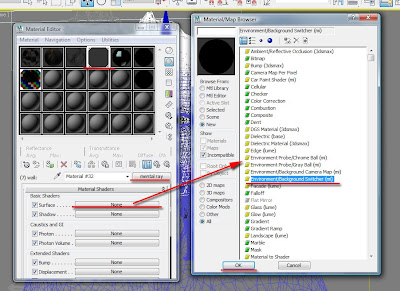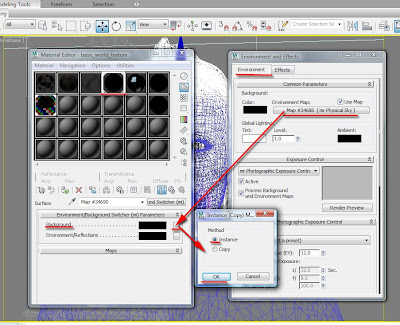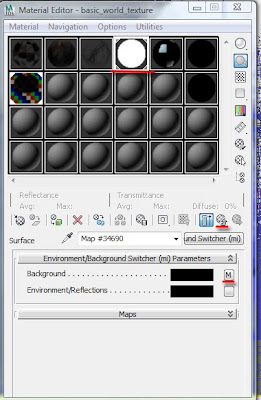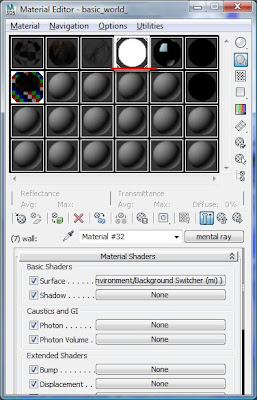Also note that the FG (i.e. final gather) was already saved and frozen while the back wall was visible to the camera.

Once the wall was made not visible to the camera, Max/mental ray weren’t able to read the hair opacity accurately due to the environment map (i.e. mr Physical Sky).


After having tried every possible avenue (i.e. assigning the matte/shadow/reflection (mi) shader to wall, make the wall not to cast shadows etc...) nothing seemed to have worked; apart from assigning the "environment/background switcher(mi") parameters shader to the wall(i.e. not visible to the camera).
To apply it, simply load the mental ray shader first,as explained in the "Mental ray_Using ambient occlusion (AO)as a separate pass" tutorial below.
1-Once loaded, click on its surface toggle and choose the "environment/background switcher (mi") shader from the "material/map browser" dialog list.

2-Next, open the "environment and effects" dialog box; drag and drop the environment map toggle content (i.e. mr physical sky) onto the environment/background switcher background toggle. Choose the copy instance method, to close the dialog.





Note that, mental ray doesn’t read properly the alpha channels generated from standard material shaders; therefore opacity bitmaps are required to be applied to the cutout toggle of the arch & design shader.

Rendered alpha channel generated by the cutout toggle

I hope you have found this post useful.
Video Captions available (CC)
Video Captions available (CC)
Video Captions available (CC)
Checkout below my other Courses with High Resolution Videos, 3d Project files and Textures included.
 |
| Course 1: Exterior Daylight with V-Ray + 3ds Max + Photoshop Course 2: VRay 3ds Max Interior Rendering Tutorials |
 |
| Course 3: Exterior Night with V-Ray + 3ds Max + Photoshop |
 |
| Course 4: Interior Daylight with V-Ray + 3ds Max + Photoshop |
 | ||
Course 5: Interior Night with V-Ray + 3ds Max + Photoshop
|
Post-production techniques
Tips & tricks for architectural Visualisation: Part 1
Essential tips & tricks for VRay & mental ray
Photorealistic Rendering
Creating Customised IES lights
Realistic materials
Creating a velvet/suede material
FoxRenderfarm
www.arroway-textures.com
Renderpeople
Gobotree














I ran into this problem a couple of months ago with some light cards I was trying to hide from the camera. I to had to put the ray switcher into a mr shader to overcome the problem. I do not remember the rest at this time because the file is at work; however, it is important to note that I am using 2011 & the problem is there too.
ReplyDeleteLikewise, there was also another way around this problem too, but I did not like it. The other way around the problem was for me to rotoscope out the light cards with a m/s/r material; however, I cannot recall as to why I did not like it. I will look at the files tomorrow at work & see if I can give more specifics.
Hi Chris,
ReplyDeleteThanks for your input here!
Yes, I would imagine that rotoscoping is definitely not the way forward.
It is worth mentioning that one can still receive/cast the shadows and GI as normal when using the "environment/background switcher background" shader on the wall/surface, provided one saves and freezes the FG first.
Thanks again Chris
Jamie